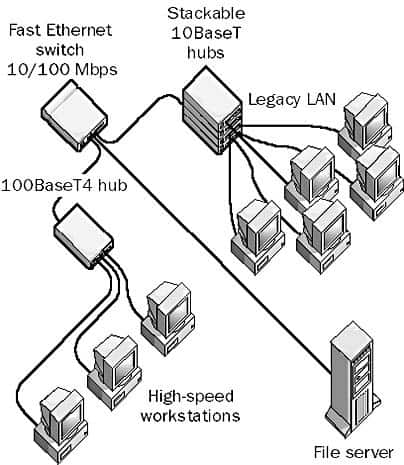Definition of 100BaseT4 in Network Encyclopedia.
What is 100BaseT4?
100BASE-T4 is a type of standard for implementing Fast Ethernet networks. 100BaseT4 is based on 802.3u, which is an extension of the 802.3 specifications of Project 802 developed by the IEEE.

How does a 100BASE-T4 network work?
100BaseT4 networks are wired together in a star topology using unshielded twisted-pair (UTP) cabling and 100-Mbps hubs or Ethernet switches. The UTP cabling can be category 3 cabling, category 4 cabling, or category 5 cabling – with category 5 (cat5) cabling and enhanced category 5 cabling being the most commonly used options. 100BaseT4 uses all four pairs of wire standard UTP cabling.
One pair is used for transmission and another pair for reception. The other two pairs are bidirectional and can be used to transmit or receive data. In this way, three of the four-wire pairs are used at any given time to provide half-duplex transmission or reception of signals. Sharing three pairs of wires for data transfer allows 100BaseT4 to make use of lower-grade cabling installed in older buildings.
The maximum length of any segment of UTP cabling connecting a station (computer) to a hub is 100 meters. This ensures that round-trip signaling specifications are met since violating these specifications can produce late collisions that disrupt network communications.
The Electronic Industries Alliance/Telecommunications Industry Association (EIA/TIA)–recommended length of cabling between the station and the wiring closet is only 90 meters, allowing up to 10 meters more of cabling for patch cables used to connect patch panels to hubs or switches. The pinning of the RJ-45 connectors used for 100BaseT4 wiring is the same as for 10BaseT wiring.
Make sure everything is cat5-compliant
Make sure all your cabling, connectors, and patch panels are fully cat5-compliant. Make sure that when UTP cabling is connected to patch panels, wall plates, or connectors, the wires are not untwisted more than half an inch at the termination point. 100BaseT4 most benefits companies with an older, preinstalled base of category 3 or category 4 cabling. 100BaseT4 hubs and switches are typically available in an autosensing 10/100-Mbps variety for interoperability with older 10BaseT networks and to facilitate an easy upgrade from 10BaseT to 100BaseT.
See also:
100BASE-T4 was an early implementation of Fast Ethernet
100BASE-T4 was an early implementation of Fast Ethernet. It requires four twisted copper pairs of voice-grade twisted pair, a lower-performing cable compared to category 5 cable used by 100BASE-TX. Maximum distance is limited to 100 meters. One pair is reserved for transmitting, one for receiving, and the remaining two switch direction. The fact that 3 pairs are used to transmit in each direction makes 100BASE-T4 inherently half-duplex.
A very unusual 8B6T code is used to convert 8 data bits into 6 base-3 digits (the signal shaping is possible as there are nearly three times as many 6-digit base-3 numbers as there are 8-digit base-2 numbers). The two resulting 3-digit base-3 symbols are sent in parallel over 3 pairs using 3-level pulse-amplitude modulation (PAM-3).